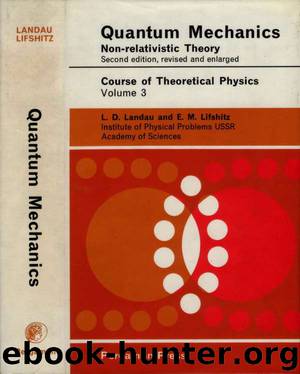Quantum Mechanics by L.D. Landau & E.M. Lifshitz

Author:L.D. Landau & E.M. Lifshitz
Language: eng
Format: epub
Tags: Physics; Schrodinger's Equation; Angular Momentum; Perturbation Theory; Spin; Nuclear Structure; Collisions; Symmetry; Atom
In case <z, however, the effect of the spin is important. Here each electron term is characterised by the number Q. as Well as A. If we simply replace A by —A, then Q = A+ 2 is changed, so that we obtain an entirely different term. The levels with A, Q. and —A, — Q are mutually degenerate. This degeneracy can here be removed not only by the effect, considered above, of the interaction between the orbital angular momentum and the rotation of the molecule, but also by the effect of the spin-orbit interaction. The conservation of the projection Q. of the total angular momentum on the axis of the molecule is (if the nuclei are fixed) an exact conservation law, and so cannot be destroyed by the spin-orbit interaction; the latter can, however, change A and 2 (i.e. there are matrix elements for the corresponding transitions) in such a way that Q. remains unchanged. This effect, alone or in combination with the orbit-rotation interaction (which alters A but not 2), may cause A-doubling.
Let us first consider the 2 II terms. For the 2 n i/2 term (A= 1, 2 =— \, Q, = |), the splitting is obtained on taking into account simultaneously the spin-orbit and orbit-rotation interactions, each in the first approximation. For the former gives the transition A = 1, 2= — ^ -> A = 0, 2= J, and then the latter converts the state A = 0, 2 = | into A = —1, 2 == \, which differs from the initial state by the signs of A and Q. being reversed. The matrix elements of the spin-orbit interaction are independent of the rotational quantum number /, while the dependence of those for the orbit-rotation interaction is determined by formula (88.1), in which (under the radical) we must replace K and A by / and Q. Thus we have for the A-doubling of a 2 II 1/2 term the expression
AE 1/2 = constant x {J+Q, (88.3)
where the constant is of the order of AB\ e. For a 2 n 3/2 term, on the other hand, the splitting can be found only in higher approximations, so that in practice &E 3/2 , = 0.
Finally, let us consider 3 II terms. For a 3 II 0 term (A = 1, 2 = —1), the splitting is obtained on taking into account the spin-orbit interaction in the second approximation (because of the transitions A = 1, 2 = —1 ->- A = 0, 2 = 0 -> A = — 1, 2=1). Accordingly, the A-doubling in this case is
entirely independent of /:
&E 0 = constant ~ A 2 je. (88.4)
For a 3 I1 1 term, 2 = 0, and so the spin has no effect on the splitting; hence we again have a formula like (88.2), but with K replaced by /:
AE X = constant x/(/+l). (88.5)
For a 3 II 2 term, higher approximations are needed, so that we can suppose A£ 2 = 0.
One of the
Download
This site does not store any files on its server. We only index and link to content provided by other sites. Please contact the content providers to delete copyright contents if any and email us, we'll remove relevant links or contents immediately.
Whiskies Galore by Ian Buxton(41728)
Introduction to Aircraft Design (Cambridge Aerospace Series) by John P. Fielding(33022)
Small Unmanned Fixed-wing Aircraft Design by Andrew J. Keane Andras Sobester James P. Scanlan & András Sóbester & James P. Scanlan(32693)
Aircraft Design of WWII: A Sketchbook by Lockheed Aircraft Corporation(32172)
Craft Beer for the Homebrewer by Michael Agnew(18087)
Turbulence by E. J. Noyes(7903)
The Complete Stick Figure Physics Tutorials by Allen Sarah(7273)
The Institute by Stephen King(6869)
Kaplan MCAT General Chemistry Review by Kaplan(6831)
The Thirst by Nesbo Jo(6770)
Bad Blood by John Carreyrou(6483)
Modelling of Convective Heat and Mass Transfer in Rotating Flows by Igor V. Shevchuk(6359)
Learning SQL by Alan Beaulieu(6169)
Weapons of Math Destruction by Cathy O'Neil(6090)
Man-made Catastrophes and Risk Information Concealment by Dmitry Chernov & Didier Sornette(5883)
Permanent Record by Edward Snowden(5689)
Digital Minimalism by Cal Newport;(5593)
Life 3.0: Being Human in the Age of Artificial Intelligence by Tegmark Max(5410)
iGen by Jean M. Twenge(5334)
